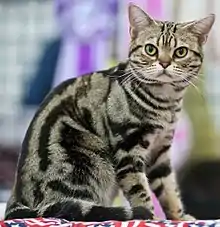| American Shorthair | |
|---|---|
 Black silver blotched tabby American Shorthair | |
| Other names | none |
| Origin | North America (formal breed development) Europe (original landrace stock) |
| Breed standards | |
| CFA | standard |
| TICA | standard |
| ACFA/CAA | standard |
| CCA-AFC | standard |
| Domestic cat (Felis catus) | |
The American Shorthair (ASH) is a breed of domestic cat believed to be descended from European cats brought to North America by early settlers to protect valuable cargo from mice and rats.[1] According to the Cat Fanciers' Association, it was the eighth most popular pedigreed cat in the world for 2020.[2]
History
When settlers sailed from Europe to North America, they carried cats on board (ships' cats) to protect the stores from mice[3]—for instance, the cats that came over on the Mayflower with the Pilgrims to hunt rats on the ship and in the colony.[4] Many of these cats landed in the New World, interbred, and developed special characteristics to help them cope with their new life and climate. Early in the 20th century, a selective breeding program was established to develop the best qualities of these cats.
The American Shorthair is a pedigree cat breed, with a strict conformation standard, as set by cat fanciers of the breed and the North American cat fancier associations such as The International Cat Association (TICA)[5] and the Cat Fanciers' Association (CFA). The breed is accepted by all North American cat registries. Originally known as the Domestic Shorthair, the breed was renamed in 1966 to the "American Shorthair" to better represent its "all-American" origins and to differentiate it from other shorthaired breeds. The name "American Shorthair" also reinforces the fact that the breed is a pedigreed breed distinct from the random-bred non-pedigreed domestic short-haired cats in North America, which may nevertheless resemble the ASH. Both the American Shorthair breed and the random-bred cats from which the breed is derived are sometimes called working cats because they were used for controlling rodent populations, on ships and farms. The American shorthair (then referred as Domestic shorthair) was among the first five breeds that were considered as registered cat breeds by CFA during 1906.[3][6]
Description
Appearance

_(cropped).jpg.webp)
The American Shorthair is a medium to large sized cat breed with males weighing between 11-15 lbs (5-7 kg) and females weighing between 6-12 lbs (2.75-5.5kg).[7] The head is large, resembling an oblong with more length than width. The ears are medium sized and slightly rounded at the tips. The eyes are large and wide. The neck is medium in length and well-muscled. The legs are medium in length and muscular. Tail is of medium length.[8]
Coat color
The American Shorthair is recognized in more than eighty different colors and patterns ranging from the brown-patched tabby to the blue-eyed white, the silvers (tabbies, shaded, smokes and cameos) to the calico van, and many colors in between.[9] Some even come in deep tones of black, brown, or other blends and combinations. Generally, only cats showing evidence of crossbreeding resulting in the colors chocolate, sable, lilac (lavender), or the point-restricted pattern of the Siamese family are disqualified from being shown.[3][8]
Health
A study in Japan of cats suspected to have kidney problems found that 47% of tested American Shorthair cats had the PKD1 mutation, which is responsible for feline polycystic kidney disease (PKD).[10] A review of over 5,000 cases of urate urolithiasis in the United States found that the American Shorthair had significantly lower odds of developing urate uroliths than mixed-breed cats.[11]
Gallery
 Black silver shaded female adult
Black silver shaded female adult Side profile of a black tabby adult
Side profile of a black tabby adult Black blotched tabby adult on a cat show
Black blotched tabby adult on a cat show Black silver tabby adult
Black silver tabby adult Laura Bush holding their family cat India, a solid black American Shorthair (2004)
Laura Bush holding their family cat India, a solid black American Shorthair (2004)
See also
- European Shorthair (or Celtic Shorthair), a similar modern breed derived from landrace European domestic short-haired cats.
- Exotic Shorthair
- British Shorthair
References
- ↑ Stephens, Gloria; Yamazaki, Tetsu (2001). Legacy of the Cat (2nd ed.). San Francisco: Chronicle Books. p. 49. ISBN 0-8118-2910-3.
- ↑ "The Cat Fanciers' Association Announces Most Popular Breeds for 2020". The Cat Fanciers' Association. February 25, 2021. Archived from the original on April 23, 2021. Retrieved February 4, 2022.
- 1 2 3 "Breed profile: About the American Shorthair". The Cat Fanciers' Association, Inc. Archived from the original on January 28, 2020. Retrieved April 22, 2016.
- ↑ "Cat Breeds – American Shorthair". Pet Source. April 22, 2014.
- ↑ "American Shorthair Breed". TICA.org. The International Cat Association. 2019. Retrieved February 19, 2019.
- ↑ Mattern, Joanne (December 2010). American Shorthair Cats. Capstone. ISBN 978-1-4296-6628-2.
- ↑ "American Shorthair". Cat Fanciers' Association. Retrieved January 7, 2024.
- 1 2 "American Shorthair Standard" (PDF). Cat Fanciers' Association. Retrieved January 7, 2024.
- ↑ Mattern, Joanne (July 2002). The American Shorthair Cat. Capstone. ISBN 978-0-7368-1300-6.
- ↑ Sato, R.; Uchida, N.; Kawana, Y.; Tozuka, M.; Kobayashi, S.; Hanyu, N.; Konno, Y.; Iguchi, Aiko; Yamasaki, Yayoi; Kuramochi, Konomi; Yamasaki, Masahiro (2019). "Epidemiological evaluation of cats associated with feline polycystic kidney disease caused by the feline PKD1 genetic mutation in Japan". The Journal of Veterinary Medical Science. 81 (7): 1006–1011. doi:10.1292/jvms.18-0309. PMC 6656814. PMID 31155548.
- ↑ Albasan, H.; Osborne, C. A.; Lulich, J. P.; Lekcharoensuk, C. (2012). "Risk factors for urate uroliths in cats". Journal of the American Veterinary Medical Association. 240 (7): 842–847. doi:10.2460/javma.240.7.842. PMID 22443437.